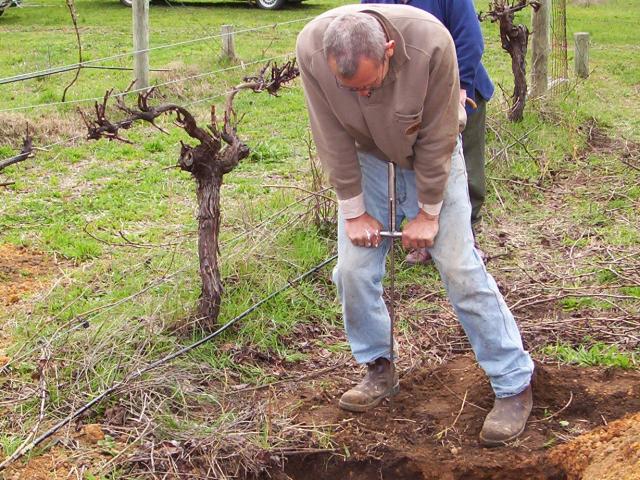When and how to soil sample
Thank you to Barry Goldspink (retired former Agriculture and Food Senior Research Officer) for contributing an opinion piece on soil sampling for this edition of the Wine Industry Newsletter.
Soil sampling in the vineyard by B.H Goldspink
Soil sampling in the vineyard is the most difficult activity to do with any accuracy. There has to be a reason to want to soil sample, and that can never be to determine fertiliser application rates.
It is also meaningless to compare soil chemistry across areas/regions, because there are too many other factors that will influence vine growth than just the soil chemistry.
Many years ago I petiole sampled vines on a rootstock trial at the Manjimup Research Facility. The nutrient uptake between rootstocks and varieties was very different, although the soil type appeared to be the same over the small area of the trial.
Soil sampling must be carried out before a vineyard is planted to determine the soil type, some of the soil chemistry and potential rooting depth.
In WA the main factor is soil pH, as many of our soils are acidic, and there have been sites where vines have not grown because the soil has been too acidic.
Prior to planting is the only time when lime can be effectively deep ripped along the vine row to raise pH. Applying lime to the surface has little, or no, impact on the soil chemistry in the main rootzone.
Most of our soils are also extremely deficient in phosphorus and trace elements, so pre-planting is also a good time to place these nutrients below the new vine so roots can grow into them, stimulating good root growth and vine establishment.
Again, neither phosphorus nor trace elements applied to the soil surface will penetrate to any real depth without cultivation, which cannot be done close to the vine row.
The only other information about the soil chemistry of note is salinity. This only applies to some areas, especially where there may be surface water seepage evident at the bottom of slopes.
There are a lot of other elements that can be analysed for, but most are irrelevant, especially as there are few standards that can be used to interpret the results.
So why would anyone spend substantial sums of money getting soil samples analysed from an established vineyard?
It should only occur when the vines are not sufficiently growing, regardless of what fertilisers are being applied, and when petiole analysis results are inconclusive. This would almost always be due to a pH problem, which inhibits the uptake of nutrients and active root growth.
In rare cases it may be due to the soil depth being too shallow and/or too wet, but these problems should have been determined prior to planting.
Salinity problems can be seen visually with leaf damage on the vine and/or white deposits on soil clods in damp soils.
Soil sampling may be used to determine historical changes in the soil chemistry due to management practices, but this has inherent problems, which need to be discussed later.
I recommend soil sampling with an auger of about 25mm in diameter. Because vine roots penetrate a very large volume of soil, and actively seek nutrients from all that soil volume. A surface sample of 10 to 15cms isn’t enough to make total sense of the soil chemistry.
Many years ago a consultant was recommending growers apply dolomite lime because the chemistry of the surface soil showed that magnesium was supposedly limiting. Petiole samples showed magnesium to be high, as it was in the subsoil. There was no need to apply dolomite at high cost to the grower.
Where to sample is critical to the result. On the shaft of the auger I suggest cutting marks into the metal every 10cm. If the depth of the auger head is 10cm, it makes it easy to mark out the sample depths.
Generally, every vine has a wet and dry side, depending on where the drippers are located along the vine row. Lying the auger down with the head touching the vine trunk on the dry side of the vine, move out to a 45-degree angle to the vine row and mark the spot 30cm from the trunk.
This is the recommended sampling site, and must be identical for all holes. The 30cm is arbitrary, but the hole must be within the vine line and the compacted soil made by the tractor tyre, and be the same distance from the vine every time.
Sampling in the wet zone must be avoided because the soil chemistry changes significantly from under the dripper to the extremity of the zone. Likewise, sampling mid row will result in another set of data, because generally fertiliser is applied between the vine row and the compact soil line, and this has the most effect on changes to the soil chemistry.
It is worth digging a trench along the vine row to determine exactly where the majority of feeder roots are located, and to what depth they penetrate.
If there is a clay layer this will often form a barrier to the majority of vine roots, as will the compact layer from the tractor tyre, but some roots will grow across the inter-row space.
Soil samples should be taken at 10cm depths down to at least 50cm, with further depths depending on the soil type and root penetration.
Soil from each of the 10cm depths should be placed in clean clearly marked (by depth) plastic buckets. Soil representing each depth, from at least 5 holes, should be combined, mixed, subsampled and placed into clean clearly marked plastic bags to be sent to a lab for analysis.
When to sample
I recommend sampling when the soil is wet, but not so wet that it’s impossible to sample when trying to remove a slurry of clay sub-soil.
I disagree with people who recommend sampling after harvest, for the reason that it is when most growers have available time. Unfortunately, this is also when the soils are bone dry and it’s almost impossible to get the auger down to any depth, especially when clay is present.
It also means that the loose topsoil will often drop out of the auger head before it can be placed in the bucket, and/or, down the hole contaminating deeper samples.
Late September, early October, is often the best time for sampling, and should always be undertaken by someone who is trained to sample in the correct manner.
Records should also be taken of exactly when and where the samples were taken for future reference.
Sampling for historical reasons can have major problems. It’s almost certain that the soil chemistry will change with time. The real problem may not be with the sampling but with the lab.
Growers should always stay with the same lab because changing labs can result in different extraction methods being used, which almost certainly will mean differences with results. Even with staying with the same lab, changes to methodology over the years due to equipment upgrades/method changes, can change results.
The only real way to investigate possible historical changes to the soil chemistry is to sample from the vine row as well as from an area well away from the end of the row, but within the same soil type. This raises a real dilemma because often the soil chemistry will probably have been different anyway between sampling sites, because that is the nature of soil variability.
My recommendation is not to go down the path of soil sampling an established vineyard unless it is absolutely necessary to try to identify a growth problem with an area of vines that can’t be identified with petiole analyses. Remember that petiole analyses show what nutrients the vine can access from a very large volume of soil, whereas soil sampling only represents a very small volume of soil that the vine may, or may not, be utilising.


